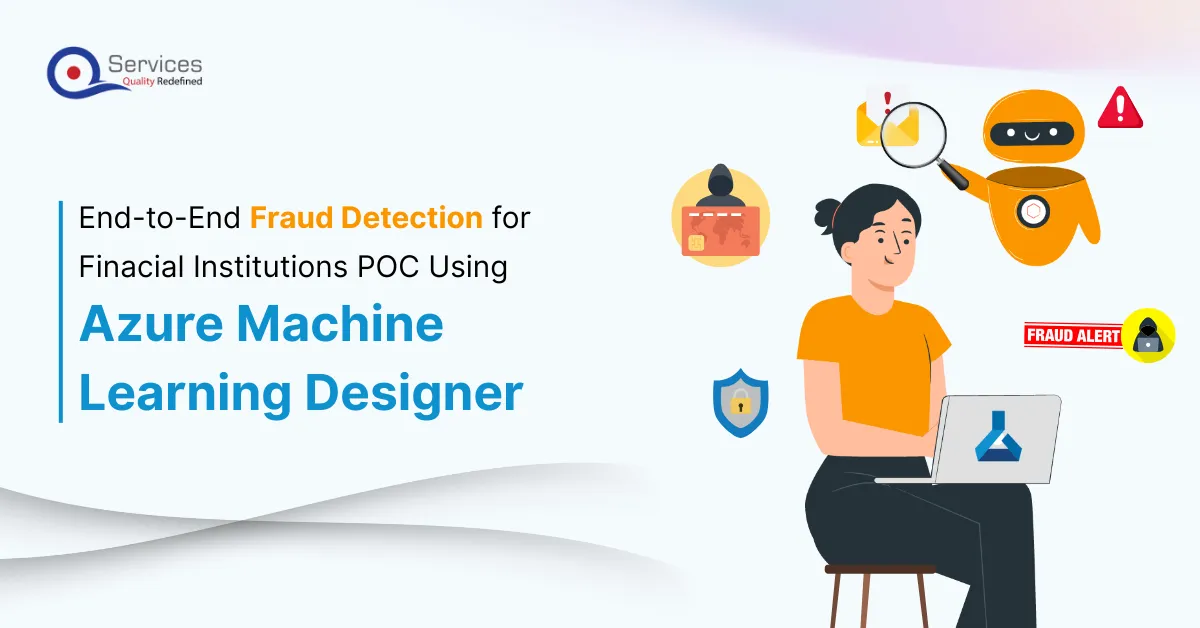
Home » End-to-End Fraud Detection for Finacial Institutions POC Using Azure Machine Learning Designer

Fraud is one of the most persistent and damaging challenges in the banking sector. Every day, fraudulent activities put financial institutions and their customers at serious risk. From fake transactions to identity theft, the threats are growing in volume and sophistication.
Traditional fraud detection methods often fall short in detecting today’s fraud intelligence. They rely on pre-set rules and struggle a lot. This is where the role of machine learning steps in. Using AI-powered fraud detection in banking is a smart way to deal with cyber threats.
This blog will explore how financial institutions can use Azure Machine Learning Designer to build a real-time fraud detection system.
Traditional banking approaches make manual analysis of data from various sources to detect fraudulent transactions. These methods often involve human review and rule-based systems, which can be time-consuming and less responsive. Banks typically review the following types of information:
Customer Profile Information- This includes basic details like the customer’s age, residential address, occupation, and type of account held.
Historical Transaction Data- Banks compare current transactions against past behaviour. This includes transaction amounts, frequency, merchant names, and the time or day of transactions.
Device and Login Data- Traditional systems may record the IP address or login location, and banks check whether access is coming from a known or common location.
Behavioural Data- In some cases, banks consider how quickly a customer performs certain actions, such as the speed of entering information or patterns of form completion.
Traditional fraud systems mean manual rules, limited detection, more errors, and slower response.
Fraudsters are much smarter today. They operate under the suited radar and mimic patterns that look legit. However, machine learning for banking is an even smarter solution. It learns from historical transaction data and evolving fraud patterns to understand what typical and fraudulent behaviours look like. AI powered frraud detection data analytics in banking
Application of machine learning in banking allows banks to:
Machine learning models enable enterprise-like fraud prevention in financial sector. In banking, it’s not just an enhancement; it’s the upgrade that drives security and survival.
The banking industry demands quick development and deployment of fraud detection systems, and Microsoft Azure Machine Learning Designer delivers just that.
It’s a part of Microsoft Machine Learning Studio and a low-code tool with drag-and-drop features to build machine learning models visually. It’s perfect for banks that want to create fraud detection systems without writing much code.
With Azure ML Designer, you can:
This means users can easily connect datasets, clean the data, build models, and run tests—all within one powerful platform.
Get free Consultation and let us know your project idea to turn into an amazing digital product.

Azure ML Designer, with its drag-and-drop interface, makes it incredibly easy to build end-to-end fraud detection systems for financial institutions. Here’s a quick start-to-finish look at how institutions can build one using the platform:
Step 1: Prepare Your Data
Start by collecting transaction data, including transaction amount, time, merchant and label as fraud or legitimate. Upload this data into Azure ML Designer.
Step 2: Clean and Process Data
Use Azure ML Designer tools to handle missing values, convert categorical features to numeric, and balance the dataset. Proper data preparation is key to building a reliable fraud detection model.
Step 3: Split Data
Divide your data into training and testing sets (usually 70/30). This allows you to train the model and evaluate it on unseen data to verify accuracy.
Step 4: Train the Model
Choose suitable algorithms like Logistic Regression, Decision Trees, or Random Forest. Train the model on your data to create the core of your fraud detection system.
Step 5: Evaluate the Model
Use evaluation metrics such as precision, recall, and F1 score to assess performance. A well-performing model in your POC should prioritize recall to catch as many fraud cases as possible.
Use Cases of AI-Powered Fraud Analytics in the Banking Industry
Fraud analytics doesn’t just only stick to transaction monitoring; it has multiple uses cases that can prevent from cyber frauds in the banking sector:
Loan fraud: Identify fake documents or suspicious applications
Wire fraud detection: Flag unusual wire transfers in real time
Credit card fraud: Detect cloned cards or compromised accounts
Application fraud: Spot suspicious patterns in credit applications
Banks can also use fraud modelling to simulate potential attack scenarios and strengthen defences.
Before deploying a full-scale fraud prevention system in banking, it’s essential to validate your approach with a Proof of Concept (like a rough draft). This POC helps test the effectiveness of models on real or representative data, ensuring you’re on the right track.
Here’s a step-by-step process of building a real-time fraud detection POC for financial services on Azure.
1. Data Collection and Exploration
First, you need a dataset that includes fraudulent and non-fraudulent banking transactions. For this POC, you can use public datasets or anonymized bank transaction logs.
Common features in fraud analytics include:
Data science exploration is the first step. You’ll identify which features influence fraud the most. For example, is there a pattern of small transactions just before a large fraudulent one? Do certain IP ranges appear more often in fraud cases?
2. Data Preprocessing
The clean the data is the more accurate the models will be. In Azure ML Designer, use built-in modules to:
Balancing the data ensures the model doesn’t become biased toward predicting “not fraud” just because most transactions are legit.
3. Building the Machine Learning Model
Drag and drop your machine learning algorithm. Popular models for fraud detection include:
These models analyse the inputs and learn patterns linked to fraud. Azure ML Designer allows you to try multiple models and compare their accuracy.
Use cross-validation and train-test splits to evaluate your models. The system shows metrics like:
High recall is crucial—this tells you the model can catch most fraud cases, even if it makes a few false alerts.
4. Real-Time Scoring and Deployment
Once your model performs well, you can deploy it as a real-time endpoint using Azure.
This allows your banking app or backend system to send live transaction data and get an instant fraud score. If the score is high, the system can:
Real-time fraud detection architecture connects model predictions to action, protecting users while keeping the experience smooth.
5. Monitoring and Updating
Fraud patterns change fast. That’s why it’s important to continuously monitor model performance and retrain it with fresh data. Azure helps you set up retraining pipelines, model monitoring dashboards, and alerts when accuracy drops.
You can also integrate Azure Application Insights and Power BI for reporting and decision-making.
Quick Comparison: Traditional Fraud Detection vs. Machine Learning Approaches
Share your project idea with us. Together, we’ll transform your vision into an exceptional digital product!

Fraud detection using AI and machine learning in banking is no longer an experiment. It’s a real, proven solution being used by banks globally. With tools like Azure Machine Learning Designer, building a fraud detection system isn’t much difficult or require large tech teams. Even small or mid-sized institutions can build a working POC in weeks, not months.
With the combination of historical transaction data, real-time analytics, and cloud automation, banks can stay one step ahead of fraudsters.
Azure Machine Learning Designer is a low-code, drag-and-drop platform to build and deploy machine learning models. It helps banks create fraud detection systems quickly without extensive coding.
End-to-end fraud detection covers the entire process—from collecting transaction data to real-time monitoring and flagging suspicious activities automatically in banking systems.
A POC is a small-scale test to verify if a fraud detection model works well on real banking data before fully implementing it.
Common data includes transaction amounts, timestamps, merchant IDs, user details, device information, and labels marking transactions as fraud or legitimate.
Algorithms like Logistic Regression, Decision Trees, Random Forest, and Gradient Boosted Trees are effective in detecting fraud patterns in transaction data.
Yes, Azure ML Designer supports deployment as web services, which can easily integrate with banks’ existing transaction processing and monitoring systems.
Machine learning models can analyse transactions and flag suspicious activity in real time, often within seconds of the transaction occurring.
By learning from historical data and adapting to new patterns, machine learning models can better distinguish between legitimate and fraudulent transactions, reducing false alarms.
Traditional methods rely on static rules and manual checks, which are slow, less accurate, and often fail to catch sophisticated or new fraud techniques.
Models should be regularly retrained with fresh transaction data to adapt to evolving fraud tactics and maintain detection accuracy.

Have a one on one discussion with our Expert Panel

Secure access is vital for organizations managing digital identities in today’s landscape. While both CIAM and IAM secure user identities, they serve different purposes — CIAM for customers and IAM for employees. This article explores their key differences and how to choose the right system.

For decades, traditional banking systems handled only basic transactions. The digital era exposed their limitations in speed and adaptability. Evolved core banking now powers seamless, future-ready financial services.

As digital expectations grow, customers now demand speed, ease of use, and 24/7 availability. To meet these demands at scale, digital-only banks choose business process automation in the banking industry to deliver consistent, responsive, and personalized service.

Founder and CEO

Chief Sales Officer
